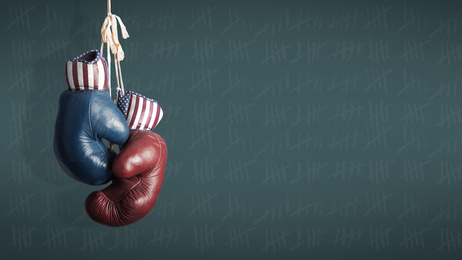Nate Silver released FiveThirtyEight.com’s 2016 presidential election forecast today. His model currently gives Hillary Clinton an 80 percent chance of beating Donald Trump in November. FiveThirtyEight sees Clinton as the favorite in Iowa, one of twelve “states to watch,” but her odds of carrying our state are somewhat lower than her odds of winning at least 270 electoral votes.
Clinton’s campaign bought more than a million dollars of air time in Iowa to run a mix of positive and comparative television commercials during the second half of June and July. That’s part of a $25.8 million ad buy in the eight states the presumptive Democratic nominee considers most competitive.
Public Policy Polling has published two Iowa surveys this month, both commissioned by progressive advocacy organizations. The first had Clinton leading Trump by 44 percent to 41 percent. The second, released yesterday, showed Clinton ahead of Trump by 41 percent to 39 percent.
Iowa’s electoral votes have gone to the Democratic nominee in six of the last seven presidential elections. (The exception was President George W. Bush’s narrow victory over John Kerry here in 2004.) However, no electoral vote projection I’ve seen considers Iowa a safe bet for Clinton. While none to my knowledge currently forecast our state leaning to Trump, the pundits and number-crunchers do not agree on whether Iowa leans Democratic or has no clear favorite going into the general election campaign. Follow me after the jump for the breakdown.
Forecasts seeing Iowa as leaning Democratic
Nate Silver explained the methodology of his general election forecast model here. The “polls-only” forecast gives Clinton a 71 percent chance of winning Iowa. She has a 62.9 percent chance of winning the state according to the “polls-plus” forecast, which takes into account some economic indicators and historical data. FiveThirtyEight’s “now-cast,” predicting who would carry Iowa if the election were held today, sees Clinton with a 67.8 percent chance of winning.
The Larry Sabato “Crystal Ball” forecast has Iowa as a “lean Democratic” state, along with Nevada, Colorado, Ohio, Pennsylvania, New Hampshire, Virginia, North Carolina, and Florida.
The most recent Rothenberg & Gonzales Political Report ratings, published on May 19, put Iowa in the “lean DEM” category, along with Pennsylvania. Stuart Rothenberg and Nathan Gonzales see Colorado, Florida, New Hampshire, Ohio, Virginia, and Wisconsin in the more competitive “Toss-up/Tilt DEM” category.
The Election Projection website’s Scott Elliott sees Iowa as a “Weak DEM” state, as of June 6. Other states in that category: Oregon, Arizona, Minnesota, Ohio, Pennsylvania, New Hampshire, Virginia, Florida, and North Carolina.
Forecasts seeing Iowa as a toss-up
The ABC News presidential state ratings, most recently updated on June 17, have Iowa as a toss-up along with Ohio, Florida, North Carolina, Virginia, and New Hampshire.
The Cook Political Report electoral college scorecard from the last week in May shows Iowa as a toss-up, along with New Hampshire, North Carolina, Ohio, and one electoral vote in Nebraska.
The Washington Post’s Chris Cillizza and Philip Bump published “The Fix” blog’s first electoral college projection in late May. Iowa is one of seven toss-ups, along with Florida, New Hampshire, North Carolina, Ohio, Virginia, and Wisconsin (which I found odd).
National Public Radio’s Domenico Montanaro explained the NPR general election ratings here. Iowa is one of five “pure toss-up” states, along with Ohio, Colorado, Florida, and North Carolina.
The NBC News Battleground Map released in early May has Iowa as a toss-up, along with Colorado, Florida, New Hampshire, North Carolina, Ohio, Virginia, and one electoral vote in Nebraska.


2 Comments
Do polls measure tolerance for risk?
After 8 years of a Democratic President it is evident that Clinton is not heeding Sanders advice to run a populist campaign for change in the face of a middle class that has continued to fall behind economically despite Obama’s best efforts. You don’t have to run against Obama to represent change. But Clinton very obviously represents the status quo. I don’t care who she is running against, in a year where people are obviously very restless and angry that is a very very risky proposition. For people who do not have a good job or are a couple paychecks away from being broke the status quo is not the safe option. If people who only vote in presidential elections are desperate enough then change is a risk they will take. I don’t think a 6 or 8 point Clinton lead in the polls is safe in this environment.
Caretaker Wed 29 Jun 8:56 PM
I tend to agree
that she presents as a status quo candidate, not a change candidate. That may be out of step with much of the electorate.
Fortunately, she will be running against a candidate who is disliked at a historically unprecedented level. No major-party nominee in recent history has had unfavorable numbers like Trump’s. Look at this chart by Adrian Gray:
desmoinesdem Wed 29 Jun 10:31 PM